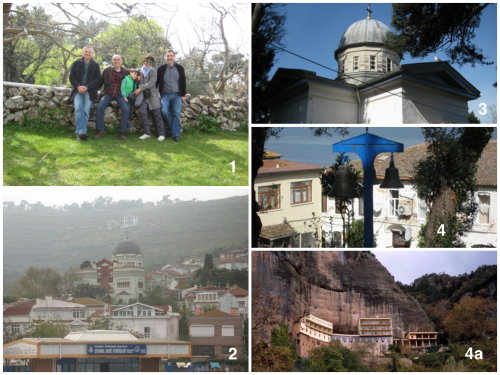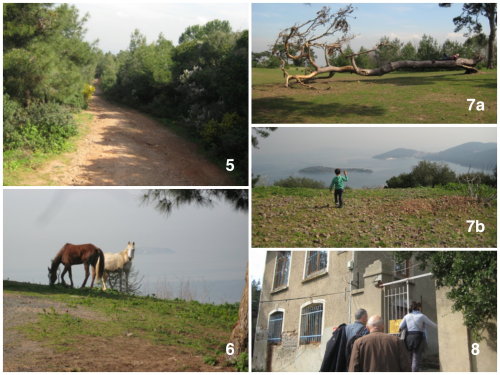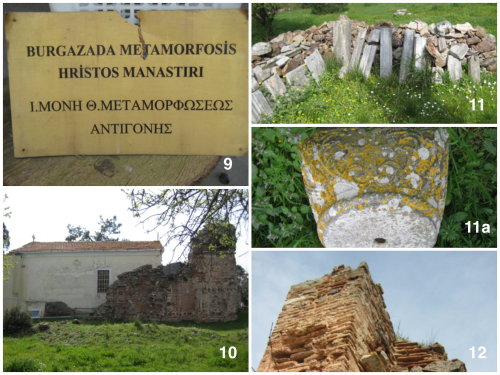
ANAMED Fellow Sotiris Fotakidis writes about his visit to Burgazada, one of the Princes’ Islands off the coast of Istanbul, and gives a brief history of the Church of the Transfiguration…
On Saturday March 12, 2016, I visited Burgazada, the island of Antigone in Greek, one of the Princes’ Islands. I made the trip together with my friend Apostolos Paraforos, my colleague Buket Bayri, her husband Haldun Bayri, and their son Cem. (pic. 1)
My purpose was to visit the archaeological site and to see the stone architectural sculptures of the Church of the Transfiguration. This archaeological site is situated on the top of a hill next to the port. (pic. 2)
After arriving at Burgazada we started our walk. Outside the port settlement we passed the Monastery of St. George “Karypi.” (pic. 3) It is built in an idyllic location (pic. 4) on a fertile hillside opposite the island of Kınalıada (the island of Proti in Greek). The current form of the monastery dates to the 19th century, but its precise original construction is not known. It shouldn’t be earlier than the 17th century, because earlier visitors to the island make no reference to it. In 1728 a certain Meletios was the first person to mention a monastery on the island, though he didn’t name it. In 1774, after the end of the Russo-Turkish War, refugees from Bozcaada (the Greek Tenedos) settled in the Monastery of St. George “Karypi,” providing the first specific reference to the place. Thereafter, it is known that the monastery became a dependency of the monastery of “Mega Spileon” of Kalavryta in Greece (pic. 4a). In 1894 the church of the monastery suffered extensive damage from an earthquake. As a result, cracks appeared all the way to the foundations of the church. Symeonaki Siniosoglou re-erected the church and was proclaimed the great benefactor of the monastery. Nowadays, the church of this monastery is a popular destination for all.

After around a 20-minute walk we arrived at the plateau of the hill, and we finally saw the archeological site of the Church of the Transfiguration. During our walk, the landscape and the surrounding views were amazing. (pic. 5, 6)
The Monastery of the Transfiguration
The Monastery of the Transfiguration was built on a plateau around 170 m above sea level (pic. 7a, 7b). Entrance today is made through a house built next to the Byzantine ruins and the new church (pic. 8, 9). The original Byzantine church was built in the 9th century A.D. during the reign of the Byzantine Emperor Basil I Macedon. The emperor himself is often credited with the monastery’s construction, said to be on the ruins of an ancient temple, perhaps dedicated to Zeus. The monastery was renamed that “of the Theokoryphotos” (Lord’s Peak) by later monks and it was here that Emperor Romanos Lekapenos deported Stephanos Magister in 921. The monastery’s precincts occupied most of the plateau and its property included the majority of the island (forests, mountains, etc.), except for the gardens and vineyards around the port town, the only settlement on the island at that time. It also owned land on the Asian coast opposite the island.

There are various reasons given for the destruction of the monastery in 1630. One story reports that the sultan was irritated by seeing lights from the monastery during Ramadan in that year and had it destroyed. In the aftermath of the destruction, whatever its cause, most of the building materials were used by the Christian inhabitants of the island to build the Church of St. John. Marble parts and other materials of the monastery were later transferred to the Monastery of St. George “Karypi.” Finally, in 1869 Hourmouzios Triantafyllou sponsored the existing Church of Christ, the construction of which also used material from the monastery. (pic. 10)
The marble sculpture of the monastery
Large numbers of marble fragments from a variety of periods, and probably from a variety of sources, were incorporated into both the Byzantine church and its nineteenth-century successor, and even more fragments are littered around the site (pic. 11). These are all spolia. Virtually no piece could be dated as contemporaneous with the church. Only a few pieces have been published, notably the capitals. The present pieces on site fall into four general groups: capitals (pic. 11a); lintels and door frames, including those recut from columns; cornices (pic. 12), including three palmette-patterned examples that may be from the twelfth-century church; columns, colonnettes and bases; panels; and other pieces.
Other stone remains can be found on the site, as well. These probably come from an ancillary building of the monastery (pic. 13). Next to the aforementioned ruins there is a Rum (Greek-Orthodox) cemetery (pic. 14) and a little cemetery chapel dedicated to the Prophet Elijah (pic. 15). An inscription on one marble tombstone in the cemetery names “Constantinos (Koço) Katsouroglou” (pic. 17), who we imagined might be associated with the famous Koço Restaurant in Moda, next to Kadıkoy on the Asian side of Istanbul.

How to get there
A ferry line from Kabataş to the Adalar (Princes’ Islands) provides convenient transportation. Check http://en.sehirhatlari.com.tr/en for times. Burgazada is the second island where the ferry docks.
From the ferry dock, try to find the Church of St. John the Baptist erected in 1899 (the cupola is obvious from the port, pic. 17). Then carry on up the hill, heading north, passing the Sait Faik Abasıyanık Museum until you reach Büyük Çamlık. Keep heading up the hill until you reach the dirt road. It is not particularly suitable for bicycles or even “faytons” (horse-drawn carriages), so ditch both and take the trip up there on your own steam. This also allows you to enjoy the view at every step. In my opinion this is the best way to discover the island.
Information about the ‘faytons’
We asked about the prices for a fayton to take four of us (plus small Cem) up the hill. The owners of the faytons wanted 100TL for each fayton and suggested we needed two for four persons, totaling 200TL (65€) (pic. 18).
Special thanks
I would like to thank Apostolos, Buket, Haldun, and also Cem, who accompanied me on this trip. Finally, I would like to thank Prof. E. Akyürek for his suggestion to visit the archaeological site of the Monastery of the Transfiguration.
Bibliography
1. R. Ousterhout – E. Akyürek, The Church of the Transfiguration on Burgazada, Cahiers archéologiques, 49 (2001), 5–14.
2. https://el.wikipedia.org/wiki/Αντιγόνη_(νήσος), (15-3-2016).

